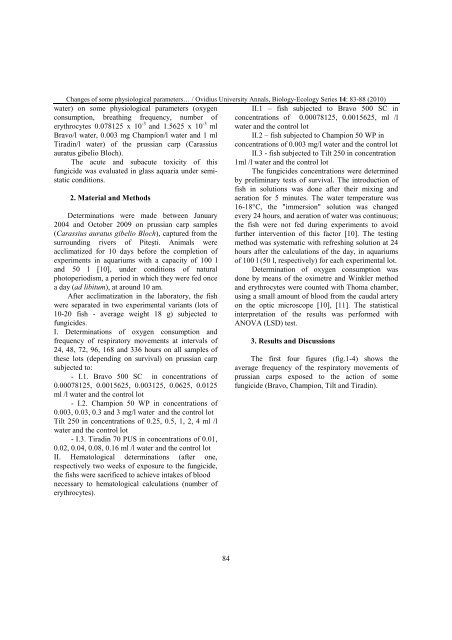VOLUM OMAGIAL - Facultatea de Ştiinţe ale Naturii şi Ştiinţe Agricole
VOLUM OMAGIAL - Facultatea de Ştiinţe ale Naturii şi Ştiinţe Agricole
VOLUM OMAGIAL - Facultatea de Ştiinţe ale Naturii şi Ştiinţe Agricole
Create successful ePaper yourself
Turn your PDF publications into a flip-book with our unique Google optimized e-Paper software.
Changes of some physiological parameters… / Ovidius University Annals, Biology-Ecology Series 14: 83-88 (2010)<br />
water) on some physiological parameters (oxygen<br />
consumption, breathing frequency, number of<br />
erythrocytes 0.078125 x 10 -3 and 1.5625 x 10 -3 ml<br />
Bravo/l water, 0.003 mg Champion/l water and 1 ml<br />
Tiradin/l water) of the prussian carp (Carassius<br />
auratus gibelio Bloch).<br />
The acute and subacute toxicity of this<br />
fungici<strong>de</strong> was evaluated in glass aquaria un<strong>de</strong>r semistatic<br />
conditions.<br />
2. Material and Methods<br />
Determinations were ma<strong>de</strong> between January<br />
2004 and October 2009 on prussian carp samples<br />
(Carassius auratus gibelio Bloch), captured from the<br />
surrounding rivers of Piteşti. Animals were<br />
acclimatized for 10 days before the completion of<br />
experiments in aquariums with a capacity of 100 l<br />
and 50 l [10], un<strong>de</strong>r conditions of natural<br />
photoperiodism, a period in which they were fed once<br />
a day (ad libitum), at around 10 am.<br />
After acclimatization in the laboratory, the fish<br />
were separated in two experimental variants (lots of<br />
10-20 fish - average weight 18 g) subjected to<br />
fungici<strong>de</strong>s.<br />
I. Determinations of oxygen consumption and<br />
frequency of respiratory movements at intervals of<br />
24, 48, 72, 96, 168 and 336 hours on all samples of<br />
these lots (<strong>de</strong>pending on survival) on prussian carp<br />
subjected to:<br />
- I.1. Bravo 500 SC in concentrations of<br />
0.00078125, 0.0015625, 0.003125, 0.0625, 0.0125<br />
ml /l water and the control lot<br />
- I.2. Champion 50 WP in concentrations of<br />
0.003, 0.03, 0.3 and 3 mg/l water and the control lot<br />
Tilt 250 in concentrations of 0.25, 0.5, 1, 2, 4 ml /l<br />
water and the control lot<br />
- I.3. Tiradin 70 PUS in concentrations of 0.01,<br />
0.02, 0.04, 0.08, 0.16 ml /l water and the control lot<br />
II. Hematological <strong>de</strong>terminations (after one,<br />
respectively two weeks of exposure to the fungici<strong>de</strong>,<br />
the fishs were sacrificed to achieve intakes of blood<br />
necessary to hematological calculations (number of<br />
erythrocytes).<br />
84<br />
II.1 – fish subjected to Bravo 500 SC in<br />
concentrations of 0.00078125, 0.0015625, ml /l<br />
water and the control lot<br />
II.2 – fish subjected to Champion 50 WP in<br />
concentrations of 0.003 mg/l water and the control lot<br />
II.3 - fish subjected to Tilt 250 in concentration<br />
1ml /l water and the control lot<br />
The fungici<strong>de</strong>s concentrations were <strong>de</strong>termined<br />
by preliminary tests of survival. The introduction of<br />
fish in solutions was done after their mixing and<br />
aeration for 5 minutes. The water temperature was<br />
16-18°C, the "immersion" solution was changed<br />
every 24 hours, and aeration of water was continuous;<br />
the fish were not fed during experiments to avoid<br />
further intervention of this factor [10]. The testing<br />
method was systematic with refreshing solution at 24<br />
hours after the calculations of the day, in aquariums<br />
of 100 l (50 l, respectively) for each experimental lot.<br />
Determination of oxygen consumption was<br />
done by means of the oximetre and Winkler method<br />
and erythrocytes were counted with Thoma chamber,<br />
using a small amount of blood from the caudal artery<br />
on the optic microscope [10], [11]. The statistical<br />
interpretation of the results was performed with<br />
ANOVA (LSD) test.<br />
3. Results and Discussions<br />
The first four figures (fig.1-4) shows the<br />
average frequency of the respiratory movements of<br />
prussian carps exposed to the action of some<br />
fungici<strong>de</strong> (Bravo, Champion, Tilt and Tiradin).





